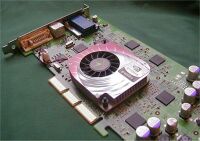Video Cards, CRTs and LCDs
Published by marco on
 If you’re in the market for a new display system, there’s an extensive review of the latest and greatest video cards on the Tech Report called ATI vs. NVIDIA: The next generation…. The first 4 pages are just geeky pictures of the video cards themselves (though, being a geek, I think the cards look pretty nice). The ‘contest’ begins on page 5, with basic system specs for the test harness and raw throughput numbers for each of the cards. The cards compared are the “Radeon 7500 vs. GeForce4 MX 440”, “GeForce4 Ti 4400 vs. Radeon 8500” and “The various Radeon 8500 flavors vs. each other”.
If you’re in the market for a new display system, there’s an extensive review of the latest and greatest video cards on the Tech Report called ATI vs. NVIDIA: The next generation…. The first 4 pages are just geeky pictures of the video cards themselves (though, being a geek, I think the cards look pretty nice). The ‘contest’ begins on page 5, with basic system specs for the test harness and raw throughput numbers for each of the cards. The cards compared are the “Radeon 7500 vs. GeForce4 MX 440”, “GeForce4 Ti 4400 vs. Radeon 8500” and “The various Radeon 8500 flavors vs. each other”.
As a recent post (Carmack on Doom’s Radeon/GF4 Support) in Programming mentioned, the GeForce4 MX is seriously misnamed, as it gets beaten in every test by the GeForce3 Ti 200. Do not buy the GeForce4 MX. They also used Serious Sam’s amazing profiling tools to pinpoint a problem in the Radeon OpenGL drivers. As an aside, those Croatians have some of the best tech going right now. Go Serious Sam!
As expected, the NVidia powerhouses still come out on top in nearly all the tests, though the Radeon 8500 topped two of the more intensive pixel shader-related tests (since it has dual shader units). This means that it can draw super-complex, gorgeous scenes faster than the GeForce4, but is still overall slower. The verdict?
“VisionTek’s Ti 4600 card pretty much blew away everything else in our tests. It’s really no contest. If you want the fastest card on the planet, get a Ti 4600. ”
Don’t forget, though, that the Radeon cards are, in general, less expensive. As the author mentions, “I’m finding myself recommending ATI cards to friends and readers who want a good all-around card at a decent price.” I’ve found myself doing the same.
At the other end of the display chain is your output device, a monitor or an LCD. Is an LCD right for you? Or is a monitor still the best (and cheapest) choice? CNet has a decent article called Behind the Numbers: Monitors which covers the differences between monitors and LCDs, what all of the numbers mean and which one you should get for which tasks.
A quick rundown, though:
- LCDs use less power than CRTs
- CRTs cost less than LCDs
- CRTs must have a high (75Hz or higher) refresh rate
- LCDs have a slower response time (“If you plan to do a lot of movie viewing or video editing, get a CRT monitor.”)
- LCDs take up much less space than CRTs
If you’re in the market for a CRT monitor, make sure to know the difference between horizontal dot pitch and diagonal dot pitch. “The rule of thumb: Avoid 17-inch monitors coarser than 0.28mm and 19-inch monitors coarser than 0.26mm.” That’s diagonal dot pitch. If the price seems reasonable and dot pitch is .20, then that’s a horizontal dot pitch.
For LCD monitors, the important things to look for are pixel response time, which is measured in rise time and fall time (time for the pixel to turn on, then off). “Movie mavens should look for a rise time of 10-20ms, while the fall time should be no more than 35-40ms.” The other important thing to look for is luminence, which is measured in candelas per square meter or nits. “[t]he range stretches from around 170 nits for a cheap panel to around 300 nits for the best—equal to a bright CRT.”